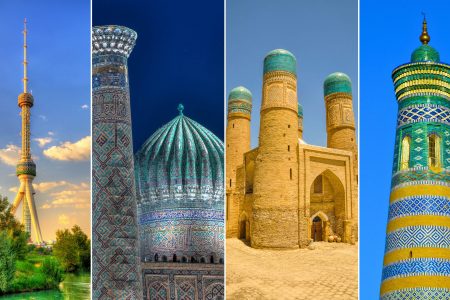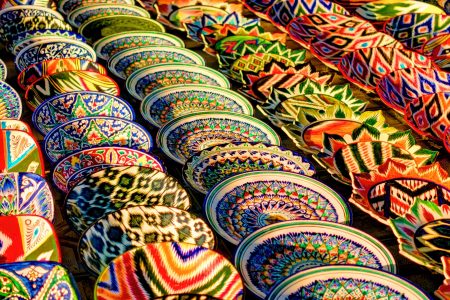Famous fairytale city “Samarkand” become an open museum city and it was recognized by the whole world through its ancient oriental fairy tales and breathtaking stories as well as rich history and architectural iconic monuments. For centuries, as the cities of Uzbekistan have token places at the Great Silk Road played an important role in the harmonization of different nations, cultures, traditions, lifestyle, and trade growths and so on. From the many famous ancient cities, only the legendary Samarkand was named the “Heart of the Great Silk Road.
“From ancient times, Samarkand has been described as the “Pearl of Islamic Architecture”, “Mirror of the World”, “Pearl of the Orient”, “The Glory of the Earth”, “Rome of the East”. It is ancient city as Rome, Athens, and Babylon as the age of city is more than 3,000 years old. Since its founding, the city has been considered an important location in the political, economic and cultural life of the Central Asia. The city’s situation at the crossroads of the Great Silk Road has given rise to the development of handicrafts such as silk weaving, the famous Samarkand paper, ceramics, blacksmithing, baking, confectionery, embroidery and other trades. The types of handicrafts that have been developed in Samarkand since ancient times have been preserved in the names of neighborhoods as each neighborhood specialized mainly to do one profession like for instance, the names “Sozangaron” (needle makers), “Kamongaron” (arrow makers) neighborhoods and other old names of neighborhoods have remained till the present day.
The rich nature of Zarafshan river valley, where Samarkand was formed, was praised in the sacred poems of Avesto. Zoroastrianism was one of the oldest religions of pre-Islamic times. In addition to that Avesto was the holy book of Zoroastrianism. In the middle of the 1st millennium BC, Samarkand city is mentioned in the form of Marokand in Greek written sources then in the Middle Ages, the ruins of ancient Samarkand became known as Afrosiab. The first written source about Samarkand city dates back to 329 BC, when it was occupied by Greek-Macedonian armies led by Alexander the Great. In the first centuries AD, the city came under the rule of the mighty Kangyuy state.
In the 6th-7th, centuries in Samarkand became a part of Turkish khanate. At the end of the 7th century – beginning of the 8th century, armies of Arab invaders appeared and conquered the whole of Central Asia and Islam religion was introduced, and the entire population of the region was promoted to accept new Islam religion.
At the beginning of the 13th century, the territory of Samarkand was completely occupied by the Mongol army led by Genghis Khan, and the city was almost completely destroyed, thousands of people, young and old were killed.
From the middle of the 14th to the 15th centuries, Samarkand and Central Asia experienced a new and unprecedented rise in economic, political, social and cultural life. Amir temur-the great commander and commander-in-chief, the founder of the great Movarounnahr centralized state * (a vast empire that now includes 27 countries), these borders stretch from the borders of present-day eastern China to Istanbul, Turkey, and from northern India to the Volga region of Russia. During the reign of Timur (14th-15th centuries), Samarkand was chosen as the capital of this empire. These are the most prosperous and popular periods in Samarkand. During that time, a large-scale urban planning and beautification works were carried out. The great ruler gathered the most skilled craftsmen and masters of his time in Samarkand, and their works have lived on for centuries. Today the monuments in Samarkand are beautiful and huge. In this city one can feel the breath of ancient history preserved in ancient ruins, madrasas, mausoleums and minarets.
Amir Temur dreamt of making the capital Samarkand a beautiful city. From every military expedition to India, Afghanistan, Iran, Syria, the Transcaucasian countries, and Turkey, he brought to Samarkand the most skilled architects, jewelers, and scholars. Within his own state, Timur was a creative creator. He was a generous supporter of artists and poets, scientists and scholars. His character is also can be seen in his grandson Mirzo Ulugbek, as he created and developed catalog and map of stars five centuries ago, still his discoveries are used till today and astonishes the whole world. In particular, in the 15th-century Samarkand Observatory, built by Ulugbek, became ruins, however, has survived till the present day ( in this observatory Mirzo Ulugbek had research in order to form 1,017 star movements by dividing year, seasons to the some categoties) and is very interesting for everyone.
It is vital to mention that during the reign of Timur and Timurids, Samarkand reached its high peak.
The rulers of European countries at that time sent many ambassadors to Samarkand for the purpose of establishing diplomatic relations, including the ambassadors of British, French and Spanish kingdoms. So far, these correspondences are kept in various museums of the globe. It is known from history that the kings and rulers in the other parts of the world dreamed of seeing the unique beauty of Samarkand.
In the following periods, independent cities were occupied by Central Asian kingdoms and khanates. From the 19th century onwards, it was occupied and ruled by Tsarist Russia as a part of the Soviet Union until the independence of Uzbekistan.
At present, famous Registan Square (15th-17th centuries) and its majestic ancient madrasas are a unique architectural monument of Central Asia. In the bygone times, during the Great Silk Road, this area was the commercial and social center of Samarkand. The mausoleum of Amir Temur and Temurids is another symbol of the beauty of ancient Samarkand. The architecture of ancient Samarkand has always fascinated everyone with its luxury and grandeur, dazzling tile ornaments, blue and beautiful domes and minarets. These include Registan Square, Amir Temur Mausoleum, Bibi Khanim Mosque, Shohi-Zinda Mausoleum Complex, Ulugbek Observatory and many other monuments can be described as an example. Nowadays, the population of Samarkand is about 600 thousand and it is the second largest and industrial city after Tashkent in Uzbekistan. Most importantly, it is one of the centers of tourism not only in Uzbekistan, but also in the world.
Nature itself has awarded Samarkand with a pleasant climate and fresh natural water – it is located in the paradise of Uzbek land. The climate of Samarkand is continental-subtropical. Its convenient geographical location and wonderful climate have always attracted everyone. The architectural and historical iconic monuments of Samarkand were included in the World Heritage List in 2001 at the 25th session of UNESCO in Finland.



